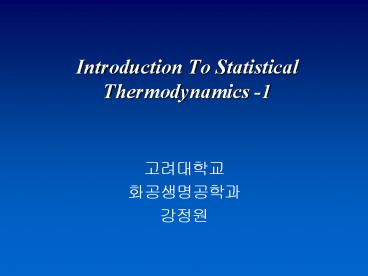Introduction To Statistical Thermodynamics 1 PowerPoint PPT Presentation
1 / 24
Title: Introduction To Statistical Thermodynamics 1
1
Introduction To Statistical Thermodynamics -1
- ?????
- ???????
- ???
2
Statistical Thermodynamics ?
- Link between microscopic properties and bulk
properties
Microscopic Properties
Microscopic Properties
T,P U,H,A,G,S m,Cp,
uij
Potential Energy
Statistical Thermodynamics
r
Kinetic Energy
Thermodynamic Properties
Molecular Properties
3
Two Types of Approach for Microscopic View
- Classical Mechanics
- Based on Newtons Law of Motion
- Quantum Mechanics
- Based on Quantum Theory
Hamiltonian
Schrodingers Wave Equation
4
Solutions
- Using classical mechanics, values of position and
momentum can be found as a function of time. - Using quantum mechanics, values of allowed energy
levels can be found. (For simple cases)
5
Purpose of statistical thermodynamics
- Assume that energies of individual molecules can
be calculated. - How can we calculate overall properties (energy,
pressure,) of the whole system ?
6
Statistical Distribution
- n number of object
- b a property (can have 1,2,3,4, discrete
values)
if we know Distribution then we can calculate
the average value of b
ni
b
1
2
3
4
5
6
7
Normalized Distribution Function? Probability
Function
b energies of individual molecule, F(b)
internal energy, entropy,
Pi
b
b1
b5
b4
b3
b2
b6
Finding probability (distribution) function is
the main task in statistical thermodynamics
8
The distribution of molecular states
- Quantum theory says ,
- Each molecules can have only discrete values of
energies - Evidence
- Black-body radiation
- Planck distribution
- Heat capacities
- Atomic and molecular spectra
- Wave-Particle duality
9
Configurations
- Instantaneous configuration
- At any instance, there may be no molecules at e0
, n1 molecules at e1 , n2 molecules at e2 , ?
n0 , n1 , n2 configuration
e5
e4
e3
3,2,2,1,0,0
e2
e1
e0
10
Weight .
- Each configuration can be achieved in different
ways - Example1 3,0 configuration ? 1
- Example2 2,1 configuration ? 3
e1
e0
e1
e1
e1
e0
e0
e0
11
Weight
- Weight (W) number of ways that a configuration
can be achieved in different ways - General formula for the weight of
- n0 , n1 , n2 configuration
Example1 1,0,3,5,10,1 of 20 objects W 9.31E8
Example 2 0,1,5,0,8,0,3,2,1 of 20 objects W
4.19 E10
12
Principle of equal a priori probability
- All distributions of energy are equally probable
- If E 5 and N 5 then
5
5
5
4
4
4
3
3
3
2
2
2
1
1
1
0
0
0
All configurations have equal probability,
but possible number of way (weight) is different.
13
The dominating configuration
- For large number of molecules and large number of
energy levels, there is a dominating
configuration. - The weight of the dominating configuration is
much more larger than the other configurations.
Wi
Configurations
ni
14
The dominating configuration
5
5
5
4
4
4
3
3
3
2
2
2
1
1
1
0
0
0
W 1 (5!/5!)
W 20 (5!/3!)
W 5 (5!/4!)
Difference in W becomes larger when N is
increased !
15
Stirlings Approximation
- A useful formula when dealing with factorials of
numbers.
16
The Boltzmann Distribution
- Task Find the dominating configuration for
given N and total energy E. - ? Find Max. W which satisfies
17
Method of Undetermined Multiplier
- Maximum weight , W
- Recall the method to find min, max of a function
- Method of undetermined multiplier
- Constraints should be multiplied by a constant
and added to the main variation equation.
18
Method of undetermined multipliers
19
(No Transcript)
20
Boltzmann Distribution (Probability function for
energy distribution)
21
The Molecular Partition Function(?? ?? ??)
- Boltzmann Distribution
- Molecular Partition Function
- Degeneracies Same energy value but different
states (gj-fold degenerate)
22
An Interpretation of The Partition Function
- Assumption
- T? 0 then q ? 1
- T? infinity then q ? infinity
- The molecular partition function gives an
indication of the average number of states that
are thermally accessible to a molecule at T.
23
An example Two level system
- Energy level can be 0 or e
24
Example
- Energy levels e, 2e, 3e , .

